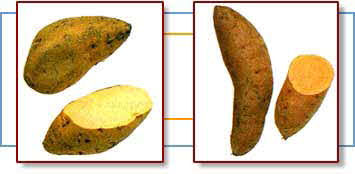FoodReference.com (since 1999)
COOKING TIPS AND HINTS SECTION
Home | Articles | Food Trivia | Today in Food History | Food Timeline | Recipes | COOKING_TIPS | Food Quotes | Who’s Who | Culinary Schools & Tours | Food_Trivia_Quizzes | Food Poems | Free Magazines | Food Festivals and Events
Cooking and Kitchen Tips and Hints, Measurements, Shopping Advice, Serving Ideas, etc.
SWEET POTATOES
See also: Stringy Sweet Potatoes; Sweet Potato Nutrition;
Sweet Potato Facts & Trivia; Sweet Potato Recipes
Sweet Potato Tips
Sweet potatoes are stored in temperature- and humidity- controlled warehouses that extend the sweet potatoes' shelf life for the entire year. Therefore, the "season" for fresh sweet potatoes is 12 months. Canned sweet potatoes are also available year 'round.
Sweet potatoes should not be refrigerated unless cooked. Store between 55 and 65 degrees F.
Always use a stainless steel knife when cutting a sweet potato. Using a carbon blade will cause it to darken.
When selecting fresh sweet potatoes, choose those that are smooth, plump, dry and clean.
Yellow, dry fleshed and orange
moist fleshed sweet potatoes The sweet potato is a member of the morning glory family, and is not related to the Yam.
The sweet potato is a member of the morning glory family, and is not related to the Yam.
Sweet potatoes should be peeled deep enough to remove the hard layer beneath the skin; they will turn dark on the outside when cooked if not peeled deep enough.
Never store sweet potatoes below 35 degrees F. Just keep cool & dry for several days storage.
Use them in soups, casseroles, puddings, baked goods, or as a substitute for white potatoes in your favorite recipes. They make a nice addition to stir-fries; cut them into thin sticks so that they will cook quickly.
Selection
Choose firm, dark, smooth sweet potatoes without wrinkles, bruises, sprouts, or decay. Even if cut away, a decayed spot may have already caused the whole potato to take on an unpleasant flavor.
Storage
Sweet potatoes spoil rapidly. To keep them fresh, store them in a dry, cool (55-60°) place such a cellar, pantry, or garage. Do not store them in the refrigerator, where they will develop a hard core and an "off" taste. If stored properly, sweet potatoes will keep for a month or longer. At normal room temperature, they should be used within a week of purchase. You may brush off any excess dirt before storing, but do not wash them until you are ready to cook them. It is the moisture from washing that will increase their spoilage.
Preparation
Wash sweet potatoes well. Cook them whole whenever possible as most of the nutrients are next to the skin, and skins are easier to remove after they have been cooked. Pierce skin with fork. Place potatoes in a pan and cook in an oven heated to 375° F for about 45 minutes or until tender. Cool potatoes slightly before removing skins. Sweet potatoes can be cooked in a microwave oven to save time. Wash and pierce potatoes, then place them on a paper towel. The cooking time for 2 medium potatoes is on high for 5–9 minutes, and 4 potatoes, 10–13 minutes. Yellow and dark orange sweet potatoes can be used interchangeably in recipes. Try not to mix the two types in a single dish, because their different textures and cooking times may affect the outcome of the recipe. The yellow variety takes longer to cook than the orange and will be done at the upper range of cooking time
Nutrition Information
• Sweet potatoes are high in vitamins A and C, and are a good source of fiber.
• ½ cup of sweet potatoes provides 1 serving from the VEGETABLE GROUP of the Food Guide Pyramid.
• Diabetics: 1/3 cup of sweet potatoes equals one STARCHY VEGETABLE diabetic exchange.
Nutrition Facts
Serving size ½ cup (100g) Cooked sweet potatoes
Amount Per Serving & % Daily Value*
• Calories 100
• Fat Cal 0
• Total Fat 0g 0%
• Saturated Fat 0g 0%
• Cholesterol 0mg 0%
• Sodium 10mg 0%
• Total Carbohydrate 24g 8%
• Dietary Fiber 3g 12%
• Protein 2g 4%
• Vitamin A 440%
• Vitamin C 41%
• Calcium 3%
• Iron 2%
*Percent Daily Values are based on a 2,000 calorie diet.
Food & Nutrition Service, USDA
COOKING TIPS
Please feel free to link to any pages of FoodReference.com from your website.
For permission to use any of this content please E-mail: james@foodreference.com
All contents are copyright © 1990 - 2025 James T. Ehler and www.FoodReference.com unless otherwise noted.
All rights reserved. You may copy and use portions of this website for non-commercial, personal use only.
Any other use of these materials without prior written authorization is not very nice and violates the copyright.
Please take the time to request permission.

